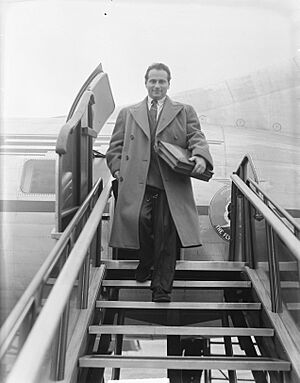Walter Susskind facts for kids
Jan Walter Susskind (born May 1, 1913 – died March 25, 1980) was a talented musician. He was a conductor, a teacher, and a pianist. Walter was born in Czechoslovakia but later became a British citizen. He started his music career in his home city of Prague. In 1939, when Germany took over Czechoslovakia, he moved to London. He spent a lot of time working in Australia, Canada, and the United States. There, he continued his work as a conductor and a teacher.
Contents
Biography
Early Life and Education
Walter Susskind was born in Prague, which is now the capital of the Czech Republic. His father was a music critic from Vienna, and his mother was a piano teacher. Walter studied music at the State Conservatorium. One of his teachers was the famous composer Josef Suk. Suk was also the son-in-law of another well-known composer, Dvořák.
Later, Walter studied how to be a conductor with George Szell. He even became Szell's assistant at the German Opera in Prague. Walter made his first appearance as a conductor there. He led the orchestra for the opera La traviata.
Moving to Britain
In March 1939, Walter Susskind was playing piano in Amsterdam. At that time, Germany took control of Czechoslovakia. His mother told him it was not safe to go back home. She survived the war, but was held in a place called Theresienstadt.
With help from a British journalist and officials, Walter came to Britain as a refugee. He formed a music group called the Czech Trio. In this group, he played the piano. The Czech ambassador in London, Jan Masaryk, encouraged them. The trio soon got many chances to perform.
Career in Britain
In 1942, Susskind joined the Carl Rosa Opera Company as a conductor. He worked with famous singers like Heddle Nash and Joan Hammond. In 1943, he married a British cellist named Eleanor Catherine Warren. They were married until 1953. In 1944, he made his first recording. He conducted music from the opera Turandot with Joan Hammond singing.
After World War II, Walter Susskind became a British citizen. Even though he worked outside Britain for much of his life, he always said he would keep his British citizenship.
Leading Orchestras Around the World
Walter Susskind's first main job as a music director was with the Scottish Orchestra. He worked there from 1946 to 1952. After that, he moved to Australia. From 1953 to 1955, he was the conductor for the Melbourne Symphony Orchestra.
He then worked for a short time in Israel and South America. In 1956, he became the head of the Toronto Symphony Orchestra (TSO) in Canada. He stayed with them until 1965.
Teaching and New Projects
In 1960, Walter Susskind started the National Youth Orchestra of Canada. This orchestra helps young musicians learn and perform. He also taught conducting at The Royal Conservatory of Music. Some of his students became conductors themselves.
From 1968 to 1975, he was the conductor of the St. Louis Symphony Orchestra in the United States. He made over 200 recordings with them! While in St. Louis, he also taught at Southern Illinois University Edwardsville. He was also involved with the Mississippi River Festival. This was a yearly outdoor concert series.
Walter Susskind was an artistic advisor for the Cincinnati Symphony Orchestra from 1978 until he passed away in 1980. On May 3, 1971, he returned to the New York City Opera. There, he conducted an opera called Makropulos Case.
Walter Susskind died in Berkeley, California, when he was 66 years old. His personal collection of papers and recordings shows his amazing career. It includes his work as a conductor, a piano player, and even a composer.
Notable Recordings
Walter Susskind made many recordings during his career. These recordings helped share his musical talent with people all over the world. He conducted pieces by famous composers like:


